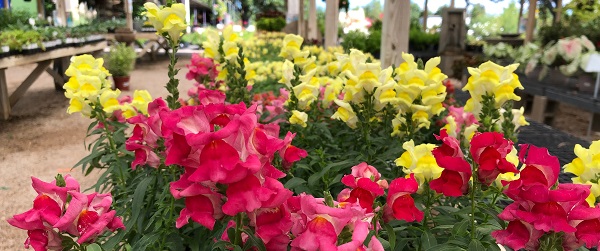VEGETABLES
Onions transplants should be planted before mid-month. Click HERE for planting instructions.
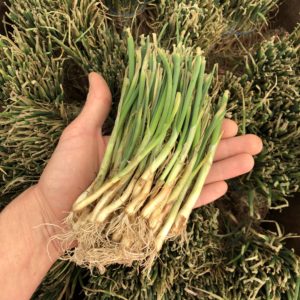
Seed Swiss chard, carrots, turnips and radishes directly into the garden. Cover seedlings during hard freezes.
Cool-season greens such as lettuce, spinach, mesclun greens and mustard greens should be planted early in the month from seed.
Potatoes are usually planted around President’s Day. Choose varieties such as Kennebec or Red Lasoda. Cut seed potatoes into sections with at least one “eye” per section. Lay them out to dry in a shady spot. Shaking them in a bag first with “dusting sulfur” will help keep them disease free. After a few days of drying, plant them in a trench and cover with about an inch of soil. As the stems grow, continue to fill the trench with a loose soil/compost mix. This is called “hilling up”, and the more of the stem that is covered, the more potatoes will be produced from the roots that grow out from them! Click HERE for growing instructions.
Remember to fertilize your cool season vegetables with Happy Frog Marine Cuisine or Happy Frog Tomato and Vegetable Fertilizer. Watch for loopers on Cole Crops, and use Bt or Spinosad to keep them away. Aphids may also be a problem that insecticidal soap, Spinosad Soap or a good spray of water can control. Be sure to look UNDER the leaves for them!
ANNUALS AND PERENNIALS
Continue fertilizing winter color beds and pots with Nelson Plant food ‘Color Star’ time-release fertilizer to maintain vigor and bloom.
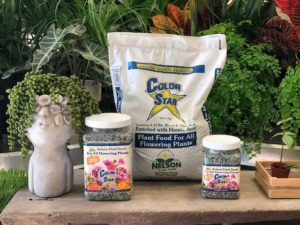
Cut herbaceous and woody perennials like Lantana back to a few inches in late February. Cut Ornamental Grasses back late February to 6”-12” before new growth appears.
Click HERE for Pruning Guidelines.
TREES AND SHRUBS
Complete pruning of dormant plants by the end of the month. January 31 was the cut-off for pruning Live Oaks and Red Oaks, due to the activity of the Nitidulid Beetle, which can spread the Oak Wilt Fungus.
February is the month to prune and shape roses. Remember to fertilize in March (after pruning in February) with a balanced fertilizer such as organic Maestro Gro Rose Glo, and water-in well.
Plant roses this month to establish root systems for spring blooms. Use a quality compost such as Happy Frog Soil Conditioner or Heirloom Mushroom Compost to get them off to a good start.
TURF
Warm-season weed seeds will be germinating soon. An application of a pre-emergent herbicide such as HiYield Turf and Ornamental Grass Stopper with Dimension at this time will prevent many weed seeds from germinating. Certain weeds such as Khaki Weed and Goat Heads will require Fertilome Broadleaf Weed Control with Gallery for pre-emergent control. Always check the label for the list of weeds controlled. Application of 1/2″ of water is necessary to activate the ingredient.
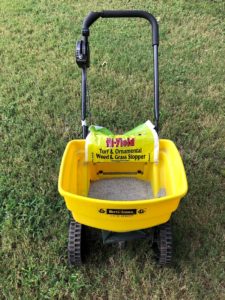
Organic Corn Gluten may be used at the rate of 20#/1000 sq ft. It must be activated with 1/2″ of water, then must remain dry for at least 4-5 days. Turn off irrigation and check the forecast for dry days for best results.
The cool-season weeds which have been growing in the lawn all winter are best controlled NOW with a selective post-emergent herbicide. Spray only the weeds, not the entire lawn. If you wait for these weeds to flower and go to seed, they are not as easy to control. You can mow them and wait for a new flush to increase efficacy. Remember, timing is very important in weed control. Post-emergent herbicides should be handled with care and used responsibly. Do not use under the canopy of trees or tree roots will be damaged. Avoid drift. Consult nursery staff for specific recommendations.
Organic non-selective options are available. Non-selective means it will affect any plant it comes in contact with and may be used as a “spot spray” on weeds in lawns. Mix 1 gallon of 20% Horticultural Vinegar with 2 tablespoons of orange oil and 2 tablespoons of Dawn Dishwashing Liquid for an effective “burn back” control of weeds. Since this affects only the above ground parts, reapplication after new growth appears will result in more effective control. Click HERE for more information.
Curb your impulse to buy a “weed and feed” product. These products do not specifically target weeds, and can harm your trees and shrubs. They are also quite high in inorganic nitrogen which has shown to promote disease in lawns. Fertilizer should not be applied until March or April, or after you have mowed your lawn at 2-3 times. We recommend MicroLife organic fertilizers with beneficial microorganisms and mycorrhizal fungi which assist the roots with the uptake of water and nutrients. Organic forms of nitrogen are slow release as they require microorganisms to break down the nitrogen to a usable form.
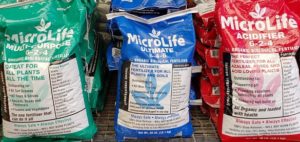
Using proper cultural practices can lead to a healthier, denser lawn which can crowd out weeds. Applying a granular post-emergent herbicide to the lawn after it is just starting to “green up” may be damaging to the lawn itself. Perhaps the most damage is done to our tree roots, as the tree roots extend 1 to 1 ½ times the height of the tree out into the yard. The granular herbicide washes into the root zone of the tree and can weaken our trees and predispose them to insects and disease. As with all herbicides, using the correct product and correct timing can be the difference between success and failure! Click HERE for our Lawn Care Schedule for Central Texas.




